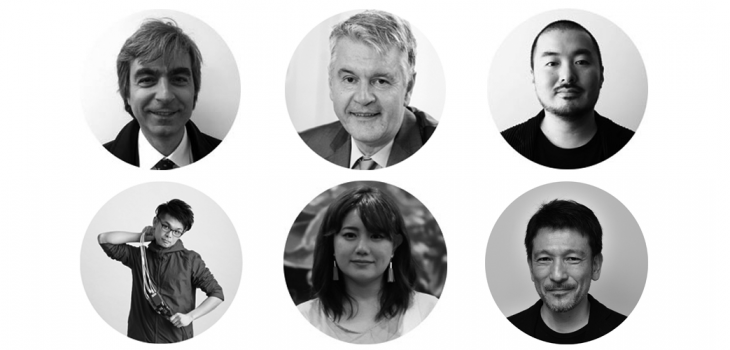DAY1 | 2019.12.12
AIとデザイン(中国最新情報),ロボティクスと情報化施工
AI & Design (in China), Robotics & i-Construction

中国におけるAIとデザイン
Artificial Intelligence and Design in China
コスタス・テルジディス | Kostas Terzidis
同済大学 デザインとイノベーション学部 教授・Shang Xiang研究室ディレクター
Professor at Tongji University’s College of Design and Innovation + Director of Shang Xiang Lab
Summary: Creativity is a peculiar area in artificial intelligence. So far, none of the AI advancements addressed design properly or even successfully. Neural networks, while successful in many pattern recognition and processing tasks, have shown very poor results in design. The problem is that neural networks are passive systems. They are perfect systems working in an imperfect world. They are trying to extract information from a noisy world in the best possible way. But that’s not the case in design. The world of design is perfect. It is an ideal world which exists only inside human imagination. So, if we want to use neural networks in design, we need to take a different approach. Instead of twisting a neural network hoping that it will come up with something interesting, it may be more effective to present it with a perfect world, i.e. a world of mathematical structures and have it make sense out of it.
Permutations are mathematical systems of arranging elements in one, many, or all possible ways and, as such, they are ideal. In general, it can be intuitively claimed that design is about permutations. One possible design solution is, after all, a permutation. Similarly, many permutations will include many possible designs. Eventually, all possible permutations will include necessarily all possible designs. So, if we can produce all possible permutations, then we must necessarily conclude that the best design will be included somewhere in that set. The question is where. To solve this problem, neural network can be useful. By training a neural network to recognize patterns the way a human designer would do, will allow it to extract from the vast set of permutations the best design. Of course, that is to say, the best according to you, or rather the ‘simulation of you’. This way we use the ideal world of everything and try to extract something out of it. Design becomes a process of elimination rather than accumulation. Instead of devising something out of nothing, this scheme extracts something out of everything.
China is at a crossroad of development where its next step will be to develop intellectual innovation especially in the areas of design and technology. While China has proven itself in adopting and adapting new ideas, its next challenge will be to develop its own original ideas. This project can help significantly in that direction and will have a great positive impact on the world of design and innovation as China is turning from “Made in China” to “Designed in China”. The goal is to address the core of artificial creativity which is neural networks and their structure as they relate to design and creativity as described above. The plan is to develop alternative neural networks and test their efficiency as a design tool. Imagine the possibilities of artificially creating designs that surpass human imagination or addressing extreme design complexity through automation. Such areas of implementation could be fashion, music, gaming, cooking, storytelling, or urban planning to name a few.
要旨:創造性は、人工知能に特異な領域である。これまで、AIの進歩はどれも適切に、デザインに対処していない。ニューラルネットワークは、多くのパターン認識や処理タスクで成功しているが、デザインでは非常に芳しくない結果を示している。問題は、ニューラルネットワークがパッシブシステムであることである。不完全な世界で機能する完璧なシステムである。それらは、ノイズの多い世界から可能な限り最良の方法で情報を抽出しようとしている。しかし、デザインではそうではない。デザインの世界は完璧である。それは、人間の想像力の中にのみ存在する理想的な世界である。したがって、デザインでニューラルネットワークを使用する場合は、別のアプローチをとる必要がある。何か面白いものが出てくることを期待してニューラルネットワークをひねるのではなく、完璧な世界、つまり数学的構造の世界を提示し、それを理解させる方がより効果的かもしれない。
順列は、要素をひとつ、多数、もしくはすべての可能な方法で配置する数学的システムであり、したがって、理想的である。一般的に、デザインは順列に関するものであると直感的に主張できる。考えられる設計ソリューションのひとつは、結局のところ、順列である。同様に、多くの順列には、必然的にすべての可能なデザインが含まれる。したがって、可能なすべての順列を生成できる場合、そのセットのどこかに最適なデザインが含まれると、必然的に結論づけなければならない。問題はどこだろう。この問題を解決するためには、ニューラルネットワークが役立つ。人間のデザイナーが行う方法でパターンを認識するようにニューラルネットワークをトレーニングすることにより、膨大な順列のセットから最良のデザインを抽出することができる。もちろん、それは、あなたに応じて最良、またはむしろ「あなたのシミュレーション」といえる。このようにして、すべての理想的な世界を使用し、そこから何かを抽出しようとする。デザインは、蓄積ではなく排除のプロセスになる。何もないところから何かを考案する代わりに、このスキームはすべてのものから何かを抽出する。
中国は発展の岐路にあり、次のステップは、特にデザインと技術の分野で知的イノベーションを開発することである。中国は新しいアイデアを採用し、適応させることで実績を上げているが、次の課題は独自のアイデアを開発することである。このプロジェクトは、その方向に大きく貢献することができ、中国が「中国製(Made in China)」から「中国でデザインされた(Designed in China)」に変わるにつれて、デザインとイノベーションの世界に大きなプラスの影響を与えるだろう。目標は、上述のようにデザインと創造性に関するニューラルネットワークとその構造である人工的な創造性の中核に取り込むことである。計画は、代替ニューラルネットワークを開発し、デザインツールとしての効率をテストすることである。人間の想像を超えるデザインを人工的に作成したり、自動化によって極端なデザインの複雑さに取り組む可能性を想像してください。そのような実装領域は、いくつか例を挙げると、ファッション、音楽、ゲーム、料理、ストーリーテリング、都市計画である。
Short bio: Kostas Terzidis is a professor at D&I at Tongji University and director of the Shang Xiang Lab. Previously, was an associate professor at Harvard University GSD (2003-2011) and assistant professor at the UCLA (1995-2003). He holds a Ph.D. from the University of Michigan, Masters from OSU, and a diploma from Aristotle University. His research is automated design and AI. He is the author of numerous academic papers and the sole author of four books: Permutation Design (Routledge: 2014), Algorithms for Visual Design (Wiley: 2009), Algorithmic Architecture (Architectural Press: 2006), and Expressive Form (Spon:2003). Between 2011-2017 he created and ran a startup called Organic Parking, Inc.
略歴: コスタス・テルジディスは、同済大学デザインとイノベーション学部の教授であり、Shang Xiang研究室のディレクターである。 1995年から2003年までUCLAの助教、2003年から2011年までハーバード大学デザイン大学院の准教授を務めていた。テルジディス教授は、アリストテレス大学で学部を卒業、オハイオ州立大学で修士号、ミシガン大学でPhDを取得した。テルジディス教授の研究は、自動設計とAIである。彼は、数多くの学術論文の著者であり、4冊の単著(Permutation Design (Routledge: 2014), Algorithms for Visual Design (Wiley: 2009), Algorithmic Architecture (Architectural Press: 2006), Expressive Form (Spon:2003))がある。また、テルジディス教授は、2011年から2017年の間、Organic Parking Inc.というスタートアップを設立し、運営した。
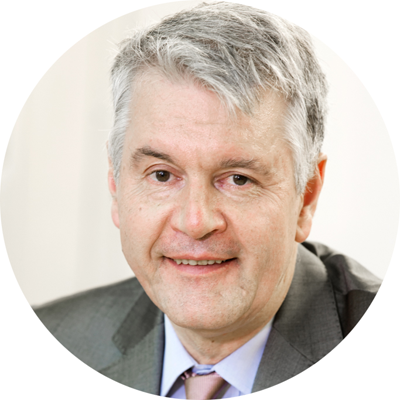
高度な建設と建築技術 – 自動化・ロボティクス・サービス
Advanced Construction and Building Technology: Automation, Robotics, Services
トーマス・ボック | Thomas Bock
ミュンヘン工科大学 建築生産・ロボティクス講座 ディレクター / 東京大学特任准教授
Chair for Building Realisation and Robotics/ Director, Technische Universitat Munchen / Project Professor of the University of Tokyo
Summary: As a student I built my own house in 1979. This experience made me analyse manufacturing technologies in car, aircraft, ship etc industries in Germany, France, USA and Japan. So I worked in most innovative construction companies in Germany where the catalog construction system had been developed, in San Antonio Texas where concrete modules were developed, in France where Raymond Camus inspired by Citroen car manufacturing developed advanced prefabrication systems for Coignet and Jean Prouve before Camus already used Citroen s light weight steel panels for building Maison due Peuple in Clichy, Toyota Production System applied to industrialized housing, construction robots to be used on site, automated building construction sites and last but not least inspired by life support systems from space stations develop robotic ambience for demographic challenge of aging society and new ubiquitous work concepts even in remote areas.
During my Dr. Eng. at Utida/sakamoto Ken of ToDai I also analysed first 50 construction robots and developed notion of ROD. Robot-Oriented Design and Management introduces the design, innovation, and management methodologies that are key to the realization and implementation of the advanced concepts and technologies presented in the subsequent volumes. Robotic Industrialization outlines technologies in building component manufacturing based on building materials and large-scale prefabrication holding the potential to deliver complex components and products which are introduced and discussed. Construction Robots shows that single task construction robots can be used for a variety of tasks ranging from digging, facade painting, interior finishing to inspection, maintenance and deconstruction. Site Automation extends the new technology of robotics in building-component manufacturing and construction introduced in earlier volumes to on-site structured environments and on-site automated factories. Ambient Integrated Robotics focuses on the relationship between improvement of production processes and enhanced product performance, including robot-oriented design and management, and usability and customer inclusion within the industry.
要旨:1979年に当時学生だった私は自分の家を建てた。この経験はドイツ、フランス、アメリカにおける自動車、航空機、船舶などの製造技術を分析することに繋がった。カタログコンストラクションシステムの開発されたドイツ、コンクリートモジュールの開発されたテキサス州サンアントニオ、シトロエンの自動車製造に触発されたレイモンドカミュが、クリシー人民の家にシトロエンの軽量スチールパネルを用いる以前、コワニエとジャンプルーヴェのため高度なプレファブリケーションシステムを開発したフランス、工業化住宅のトヨタ生産システム、建設現場で用いる建設ロボットおよび自動化、このような先進的かつ革新的な建設会社に携わってきた。そして、宇宙ステーションの生命維持装置にインスピレーションを得て、高齢化社会の課題、遠隔地においても機能する新しいユビキタスコンセプトのための、環境統合型ロボティクスも開発してきた。
博士課程在籍中には東京大学 内田・坂本研において、初期の50台の建設ロボットを分析し、ROD: Robot-Oriented Design、ロボット指向の設計の概念を開発した。ロボット指向の設計および管理に関して、後述するような、ロボットによる工業化、建設ロボット、現場自動化、環境統合ロボティクスなど先進的コンセプトと技術を実現と実装のキーとなる設計、革新、管理の方法論を紹介する。ロボットによる工業化では複雑なコンポーネントや製品を作り出すためのビルディングマテリアルと大規模なプレファブリケーションに関する製造技術の概要、建設ロボットではシングルタスクの建設ロボットが掘削・ファサード塗装・内装仕上げから検査・保守・解体までの様々なタスクに適用される事例、現場自動化においてはここまでに示したコンポーネントの製造や施工に関する新しいロボット技術の現場での自動施工や自動制作に向けた拡張についてそれぞれ紹介する。環境統合ロボティクスでは、生産プロセスの改善、ロボット指向の設計と管理を含む改良された製品性能、建設業界での運用とユーザビリティにおける関係性に焦点を当て解説する。
Short bio: Professor Bock’s research focuses on robotic construction as design, prefabrication, on-site robotics, robotic building maintenance, and recycling. A further area of specialization includes life support systems, which are robotic environments inspired by space stations to empower elderly for independent life, work and mobility.
Professor Bock studied in Stuttgart, the IIT in Chicago, and in Tokyo. At the CNRS in France, he established the first European construction robotics commission. In 1989, he became a professor for automation in construction management at Karlsruhe University, before being appointed to his chair at TUM in 1997. He is the co-founder and director of IAARC and the Asian Habitat Society and advises governments and academies worldwide. In 2017, he was awarded the DFG Seibold award for 35 years of pioneering research in construction robotics. He has (co-)authored some 500 articles in various languages and holds several honoraries and visiting professorships, professional degrees, fellowships. He is also involved in editing several journals, and in publishing the world’s first book series on “Construction Robotics” at Cambridge University Press since 2015.
略歴: ボック教授は、設計、プレファブリケーション、ロボットによる施工、維持管理、リサイクルなど、建設とロボットが研究の焦点。宇宙ステーションからアイディアを得た、高齢者の自律的な生活、仕事、移動を補助するライフサポートシステムも研究分野に含む。
シュツットガルト大学、シカゴ大学のIIT、東京大学での研究を得て、フランスCNRSでヨーロッパ発の建設ロボット委員会を立ち上げる。1989年にカールスルーエ大学の教授に着任し施工管理の自動化、1997年からはミュンヘン工科大学にて建築生産とロボティクスに関する研究に従事。各国政府や学術界へと、IAARC、アジアハビタット協会の共同創設者およびディレクターをはじめ、様々なかたちで貢献し、2017年には35年間の先駆的な建設ロボット工学の研究が評価されDFG Seibold賞を受賞。2015年からは、「Construction Robotics」(ケンブリッジ大学出版)の出版にも携わる。

ダイアローグ・コーディネーター [Dialogue Coordinator]: 中村 航 | Ko Nakamura
建築家・PhD / Mosaic Design 代表
Architect, PhD / Mosaic Design
略歴: 1978年東京都生まれ。日本大学理工学部建築学科卒業、早稲田大学大学院建築学専攻修了、同大学院博士後期課程・助手・嘱託研究員を経て2010年~2016年まで東京大学大学院建築学専攻隈研吾研究室助教。2011年アジアのストリートフードと都市に関する研究で博士号取得、設計事務所Mosaic Designを設立。2017年より明治大学IAUD教育補助講師、2018年より日本大学非常勤講師、2019年より早稲田大学非常勤講師。主な作品に「falo」「mondo」「Cori. At Commune246」「銀座スタンド」「Numbershot」他、共編著として「シェアをデザインする」学芸出版社、「クマラボイントウホク」東京大学出版会など。
Short bio: Ko Nakamura was born in Tokyo in 1978, graduated Nihon University, got master degree and PhD in Waseda University with his research about street food and the city in South East Asian cities. After working in Waseda University as Research Associate, he has been teaching at University of Tokyo as Assistant Professor with Professor Kengo Kuma in his lab since 2010-2016. Since 2017 lecturer at IAUD Meiji University, Nihon University and Waseda University. He established his own practice Mosaic Design Inc. in 2011, his major works are “Falo”, “mondo”, ”Cori. at Commune246”, “Ginza Stand” “Numbershot” and others. Major co-published works are “Design for Share” Gakugei Shuppan Sha, “Kuma Lab In Tohoku” University of Tokyo Press etc.
DAY2 | 2019.12.13
人間と建築の拡張
Human and Building Augmentation
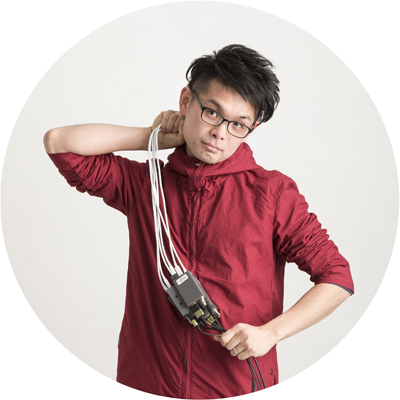
Superception(超知覚)が目指すPerceptual Engineering
Superception for Perceptual Engineering
笠原 俊一 | Shunichi Kasahara
株式会社ソニーコンピュータサイエンス研究所
Sony Computer Science Laboratories, Inc.
要旨: 知覚は我々が持つ視覚、聴覚、触覚や運動感覚器官などの入力から意味を認識、情報として形成して、我々の判断や行動を生み出す、人間の行動の根源であると同時に、「自分」自身を形成する重要な役割を持っている。本講演では、「Superception(超知覚)」という、コンピューター技術を用いて人間の感覚に介入したり、人間の知覚を接続することで、工学的に知覚や認知を拡張・変容させる研究を紹介する。
テクノロジーは、本来ある「自分」を物理的変容させたり、移動させたり、自分という存在を物理的な制約から解放する可能性を提示している。しかし「自分」というものが、どこまで変容しても「自分」であり続けるのかは全くの未知であり、また、どのように変容可能であるかも未だ多くの研究課題が残っている。
Superceptionによる「自分」知覚のエンジニアリングは、人間の身体の物理的な制約からの逸脱を実現できた際に重要となる、何が「自分」たらしめるのか、という問いに貢献しうるものであると考えている。
Summary: Perception refers to recognizing meaning and organizing it into information via the inputs of sensory organs such as eyes, ears and somatosensory organs, as a basis for actions and constructing the self.
Kasahara is leading research “Superception”, a research framework that uses computer technology to intervene in the human sensory process, or interconnect human senses, in order to create an engineered augmentation and/or transformation of human perception and cognition.
Technologies are capable to transform ourselves and overcome the physical limitation. However, there are still a lot of unexplored questions about to what extent can we be augmented and go beyond our physical nature. Superception research will contribute to this question through engineering perception of ‘self’, and lead to abilities for conscious control of perceptions and empower us to co-evolve with technology.
略歴: 博士(学際情報学)株式会社ソニーコンピュータサイエンス研究所 アソシエイトリ サーチャー。東京大学 先端科学技術研究センター特任助教。2017年東京大学大学院 情報学環博士課程修了。2008年ソニー(株)入社後、2012年MIT media lab 客員研究 員等を経て、2014年よりソニーCSLにリサーチャーとして参画。 “Superception”という研究コンセプトに基づきコンピュータによる知覚の制御や拡張に興味をもつ。これまでの研究成果はコンピュータグラフィクスやHuman-Computer Interactionの主要国際会議やテックカンファレンスでの発表に加え、体験作品の展示・テクノロジーの社会実装も行い、複合的な領域で活動している。
Short bio: Associate Researcher, Sony Computer Science Laboratories, Inc. Project Assistant Professor, Research Center for Advanced Science and Technology, The University of Tokyo. Ph.D. in Interdisciplinary Information Studies from the University of Tokyo in 2017. Joined Sony Corporation in 2008. Affiliate researcher at MIT media lab in 2012. Joined Sony CSL in 2014. Leading “Superception” research: computational control and extension of human perception. The result of his research has been presented at the major international conferences in the fields of computer graphics, human-computer interaction, and media technology festivals. He also conducts interactive exhibitions and social implementation.
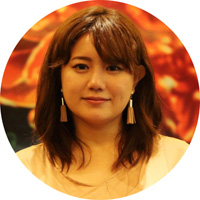
ロボット、バーチャル、他者との身体体験の共有: BodySharing
Sharing Body Experiences with Robots, Virtuals, and Humans: BodySharing
玉城 絵美 | Emi Tamaki
H2L Inc., 創業者/早稲田大学 創造理工学研究科 准教授
Waseda Univ. Associate Professor / H2L, Inc. Founder.
要旨: BodySharing,シミュレーションから今後の人の移動の変化
“BodySharing(体験共有)”とは、キャラクターの身体、ロボットの身体や、人の身体と、ユーザの様々な感覚を相互共有することです。この感覚とは、視覚や聴覚だけでなく、身体の位置覚、重量覚や抵抗覚など様々な感覚を含んでいます。
近年、“BodySharing”の多種多様なテクノロジーが研究開発されており、リモートワークシステムやリモート観光は最も有名な事例です。
“BodySharing”の特徴は、一方向だけの操作ではなく双方向の情報共有にあり、ユーザの移動時間がほぼ0になることです。移動時間が0になったとき、人の移動だけでなく、建築や都市はどのように変化していけば良いのでしょうか?
BodySharingによる人の移動に関するエージェントシステムのシミュレーションによって評価された地域や都市の特性について提示しながら議論を展開します。
Summary: Sharing Body Experiences with Robots, Virtuals, and Humans: BodySharing
“BodySharing” means sharing the various senses of user with other bodies, virtual character, robot, and other human body.
The senses include not only vision and hearing but various senses such as body position, weight, and resistance.
In recent years, “BodySharing” technology has been researched and developed. Remote work systems and Remote tourism are the most famous examples.
The feature of BodySharing is bi-directional information sharing, and user travel time is becoming almost zero.
When the travel time becomes zero, how should the architecture and city change?
We discuss the characteristics of regions and cities evaluated by agent simulation with BodySharing.
The inhabitants of the Japanese 47 prefectures are considered as the study case; a total population of 126.9 million according to the announced statistics in 2016.
As a result of our simulation, significant differences are recognized. Only rules on time and number of people restrictions are effective to suppress depopulation/overpopulation areas compared to freely BodySharing.
略歴:人間とコンピュータの間の情報交換を促進することによって、豊かな身体経験を共有するBodySharingとHCI研究とその普及を目指す研究者兼起業家。2011年にコンピュータからヒトに手の動作を伝達する装置「PossessedHand」を発表。分野を超えて多くの研究者に衝撃を与え、CNNやABCでの報道、米Time誌が選ぶ50の発明に選出。同年には東京大学にて総長賞受賞と同時に総代をつとめ博士号を取得、2012年にH2L, Inc.を創業。2015年にKickStarterにて世界初触感型コントローラ「UnlimitedHand」を発表し22時間で目標達成。内閣府 総合科学技術・イノベーション会議にて総合戦略に関する委員も務める。新たなBodySharingの研究プロダクトである「FirstVR」は、NTTドコモ5Gとの連携を2019年に発表。PossessedHand、UnlimitedHand、FirstVRは、基礎から応用まで多くの研究者に利用されると同時に、BodySharingサービスへと展開している。
Short bio: Emi Tamaki is researching to interact haptic sensation and physical sensation between computer and human. Her goal is to share rich body experiences by facilitating information exchange between humans and computers. In 2011 she announced PossessedHand controls human hands from computers. She received her Ph.D. in Interdisciplinary Informatics and also received President’s Award from the University of Tokyo in 2011. In 2012, she co-founded H2L, Inc. H2L developed a product UnlimitedHand that was published on Kickstarter that is a crowdfunding site, UnlimitedHand reached the campaign goal in only 22 hours. New research project and the product for BodySharing: “FirstVR”, which corroborates with NTT Docomo 5G, is released in 2019.
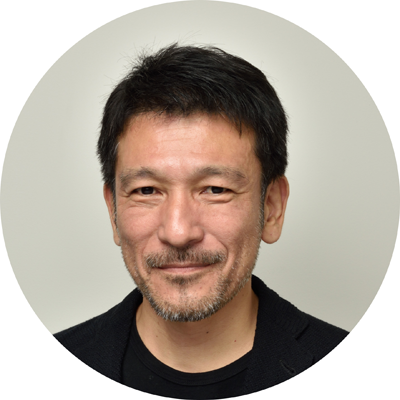
ダイアローグ・コーディネーター [Dialogue Coordinator]: 下吹越 武人 | Taketo Shimohigoshi
A.A.E. / 法政大学 | A.A.E. / Hosei University
略歴:1988年横浜国立大学工学部建築学科卒業、1990年同大学院修了、北川原温建築都市研究所を経て1997年 A.A.E.設立。現在、法政大学教授。主な受賞に日本建築学会作品選奨、英国ARアワード大賞、グッドデザイン賞など多数。主な作品に和歌の浦アートキューブ、キラービル、rim、K2 houseなど。
Short bio: 1988 Bachelor of Architecture, Yokohama National University, 1990 Master of Architecture, Graduate School of Yokohama National University, 1990-97 Worked at Atsushi Kitagawara Architects Inc, 1997 Established A.A.E., 2011 Professor in the Faculty of Engineering and Design at Hosei University
